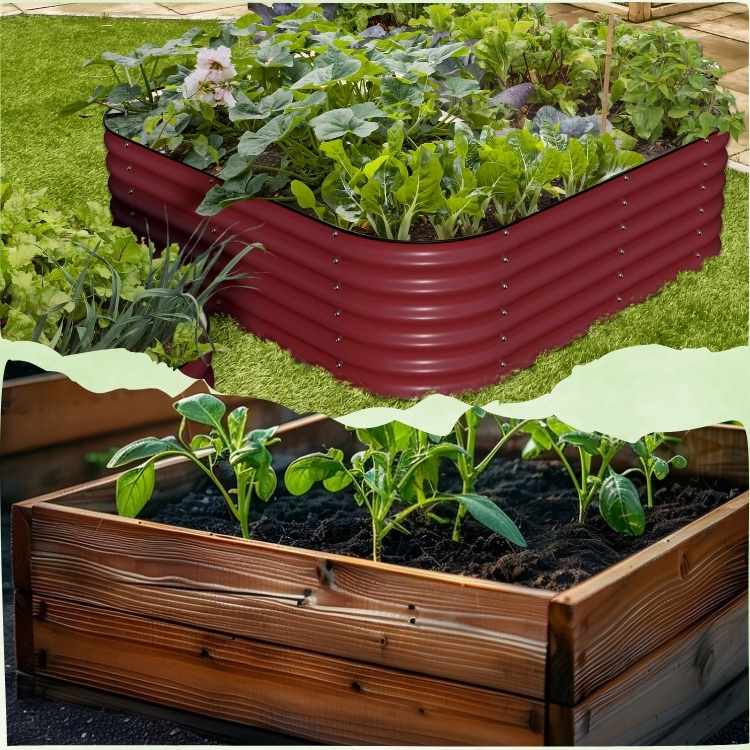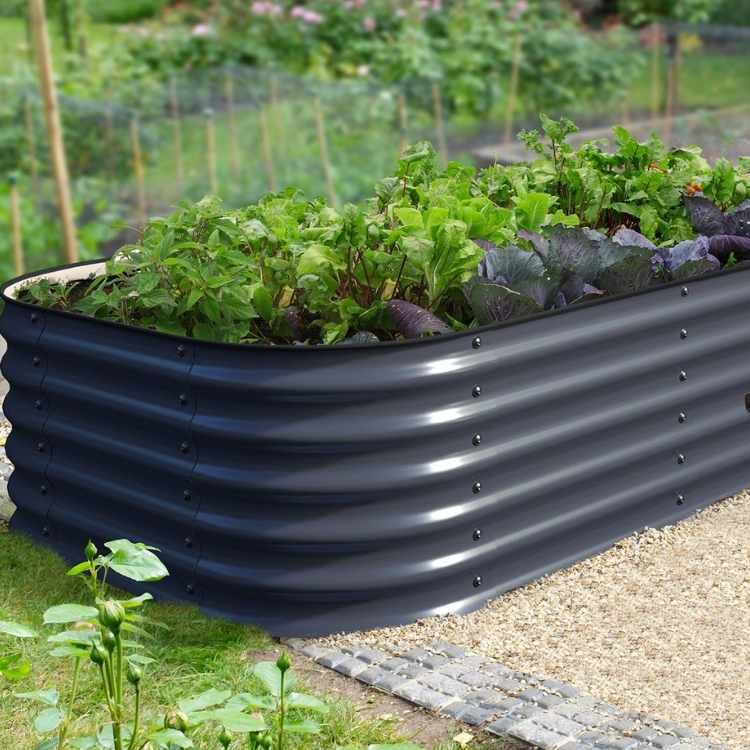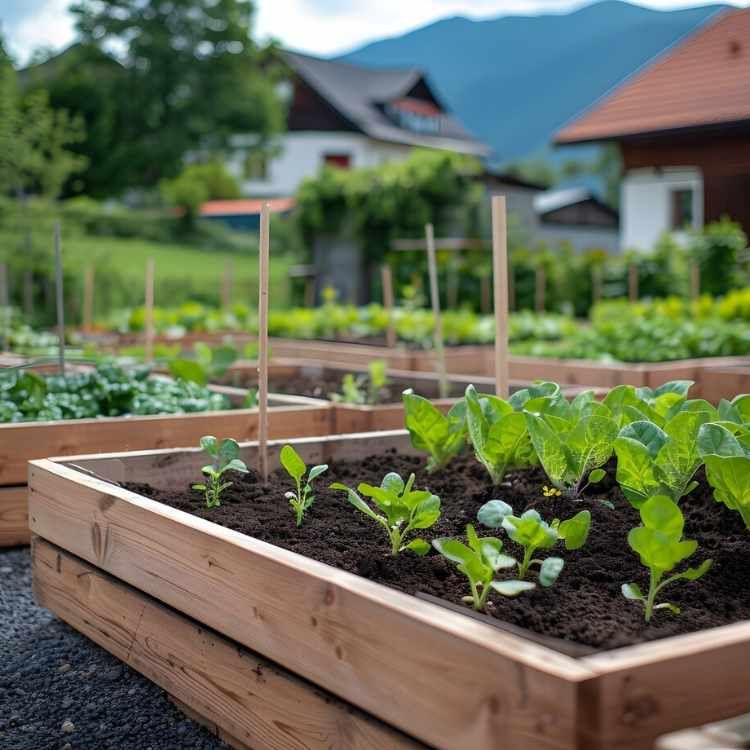
Key Takeaways
Metal garden beds offer superior durability and can enhance heat retention, which is crucial for extending the growing season.
Wooden garden beds provide a natural aesthetic and can improve soil conditions as they decompose over time.
Both materials have their advantages and challenges, and the choice depends on your specific gardening needs and climate conditions.
Understanding the heat retention properties of both materials helps in making an informed decision for your garden setup.
Quality garden beds, whether metal or wood, can be sourced from trusted suppliers like Survival Essentials, which offers a range of gardening solutions.
Thrive with the Right Garden Bed: Metal vs Wood
Gardening is not just a hobby; it’s an art and a science. The choices you make can have a profound impact on the success of your garden. One of the most crucial decisions is selecting the right material for your garden beds, especially when it comes to heat retention. This isn’t just about looks—it’s about creating the ideal environment for your plants to flourish.
Let’s dive into the world of metal and wood garden beds, unravel their secrets, and discover which one might be the hero your garden deserves.
Top Insights into Heat Retention for Garden Beds
Heat retention is a big deal for gardeners. It’s the difference between a thriving plant and a struggling one, especially during those cooler months or unexpected cold snaps. Good heat retention can mean extending your growing season, giving you a head start on spring, or keeping those veggies going well into fall.
Why the Material of Your Garden Bed Matters
The material of your garden bed affects everything from heat retention to moisture control and pest resistance. Choose wrong, and you could be setting your plants up for a tough battle. Choose right, and you’ll be their champion, providing them with the perfect foundation to grow strong and healthy.
Metal Garden Beds: Advantages and Drawbacks

Metal garden beds have been gaining popularity, and for good reason. They’re sturdy, they last for ages, and they bring a modern touch to any garden. But let’s focus on how they interact with heat—because that’s where they really stand out.
How Metal Beds Enhance Garden Productivity
Metal is a fantastic conductor of heat. During the day, metal beds soak up the sun’s rays, warming the soil within. This can be a game-changer for seed germination and for plants that thrive in warmth. But it’s not just about the daytime; metal beds can also protect your plants at night. They release the stored heat slowly, which can help prevent those dreaded frost damages.
Consider this: metal beds can act like a mini greenhouse, without the glass. It’s a simple, effective way to give your plants that extra bit of warmth they might need.
Example: A gardener in a cooler climate extended their growing season by two weeks simply by switching to metal garden beds. The extra heat retention made all the difference.
But it’s not all sunshine and warm soil. There are a few things to be mindful of when it comes to metal beds.
Concerns with Using Metal Beds in Your Garden
While metal beds are great at retaining heat, they can get too warm in the height of summer, especially in hotter climates. This means you might need to keep an eye on them, making sure your plants aren’t getting overheated. A little shade or mulch can go a long way in managing this.
Another consideration is the material itself. You’ll want to make sure you’re using galvanized metal to avoid rusting, which could not only weaken the bed but also potentially leach unwanted substances into your soil.
Wooden Garden Beds: Benefits and Limitations

Now let’s talk about wood. It’s the classic choice for a reason. Wood beds blend seamlessly into the garden, giving it a timeless, organic feel. But they’re not just pretty; they have some serious gardening benefits too.
Wood Beds: Nature’s Solution for Your Garden
Wood is a natural insulator, which means it’s good at maintaining a consistent soil temperature. Unlike metal, it won’t heat up too much in the summer sun, which can be a blessing for more delicate plants. And as wood slowly breaks down, it feeds the soil, enriching it with nutrients that your plants will love.
Wooden beds can also be a more sustainable option, especially if you’re using locally sourced, untreated lumber. You’re essentially giving new life to the wood, and when it’s time to replace the beds, they can be composted, returning to the earth they once grew from.
Potential Challenges of Wood Beds for Gardeners
However, wood isn’t without its issues. It’s susceptible to rot, especially if it’s in constant contact with moist soil. This means you’ll need to replace wood beds more frequently than metal ones. Pests like termites can also be a concern, depending on where you live and the type of wood you choose.
Another thing to consider is the treatment of the wood. Some treated woods can contain chemicals that you don’t want anywhere near your veggies. Always go for untreated, natural wood to avoid any potential contamination.
In the next sections, we’ll compare the heat retention properties of metal and wood in more detail, and I’ll guide you through choosing the best material for your gardening needs. Whether you’re looking to buy ready-made beds or build your own, there’s a solution out there that’s perfect for your garden.
Heating Up Your Harvest: Metal vs Wood
When it comes to heating up your harvest, the battle between metal and wood garden beds is a hot topic. Both have unique properties that can either benefit or challenge your green aspirations. It’s essential to understand how each material interacts with the elements, especially the sun, to harness its power for your garden’s advantage.
So, let’s unwrap this further and see how metal and wood stack up against each other in the quest for superior heat retention.
Metal beds excel in capturing and distributing heat but may require shading in peak summer.
Wood beds offer a consistent temperature, beneficial for delicate plants, but are prone to rot and pests.
Choosing between metal and wood depends on your climate, plant selection, and sustainability goals.
As we compare these two contenders, remember that your choice will directly impact your plants’ growth conditions and, ultimately, the success of your garden.
Metal and the Sun: A Heat Retention Story
Imagine a sun-soaked garden where the soil is warm and welcoming for seeds ready to sprout. This is the reality of a garden with metal beds. Metal’s high thermal conductivity means it quickly absorbs heat from the sun and distributes it evenly across the bed. This can significantly speed up germination and growth in the early season.
However, as the sun climbs higher and the days grow longer, metal beds can become too toasty. This is where strategic gardening comes into play. Use taller plants to provide natural shading, or apply a layer of mulch to help regulate soil temperature. It’s all about finding that sweet spot for your plants to thrive.
Warmth and Wood: How These Beds Hold Heat
Wooden beds are less likely to overheat, providing a stable environment for roots.
The insulating properties of wood help to keep the soil warm during cooler nights and seasons.
As wood naturally decomposes, it enriches the soil, which can be beneficial for plant health.
Wooden beds have a different relationship with the sun. Their insulating nature means they don’t heat up as quickly, but they do an excellent job of holding onto warmth once they have it. This steady warmth is excellent for plants that prefer a more consistent temperature range.
Remember, the type of wood you choose can make a big difference. Cedar and redwood are known for their durability and resistance to rot, making them excellent choices for garden beds.
As we consider the heating capabilities of metal versus wood, it’s clear that each has its place in the garden. Your choice should be influenced by your specific gardening goals, the climate you live in, and the plants you want to nurture.
Guide to Picking Your Perfect Garden Bed
Choosing the right garden bed is like picking the right foundation for your home—it needs to support everything built upon it. Here’s a guide to help you decide when to go with metal and when wood might be the better option for your garden dreams.
When to Choose Metal for Your Green Dreams
Go for metal garden beds if:
You live in a cooler climate and need to maximize heat retention for a longer growing season.
You want a low-maintenance option that’s durable and resistant to pests.
You’re looking for a modern aesthetic that can withstand the test of time.
Keep in mind that while metal beds are a fantastic choice for many, they are an investment. However, with their longevity, you’ll likely save money in the long run by not having to replace them as often as wood.
Opting for Wood: Balancing Aesthetics and Functionality
Wood is the way to go if:
You prefer a natural look that blends seamlessly with your garden’s landscape.
You’re gardening in a warmer climate where overheating soil is a concern.
Sustainability is a key factor in your gardening practices.
Wooden beds can be a gardener’s delight, offering a traditional and organic feel to your space. Just be ready to replace them every few years and keep an eye out for any signs of decay or pest infestation.
Keeping Your Green Thumb Up: Final Thoughts
Whether you choose metal or wood for your garden beds, remember that both materials have their strengths. Metal offers durability and superior heat retention, while wood provides a classic look and a more consistent temperature for your plants.
Most importantly, consider the specific needs of your garden and your plants. Think about the climate you’re working with, the amount of maintenance you’re willing to put in, and the long-term sustainability of the materials you choose.
And when you’re ready to make your choice, remember that trusted suppliers like Survival Essentials have options to suit your needs. Their range of garden beds can provide the quality foundation you need to keep your green thumb up and your garden thriving.
Now that you have all the information you need, it’s time to make your garden bed decision. Will it be the warm embrace of metal or the steady comfort of wood? Whichever you choose, your plants will thank you for the thought and care you put into their home.
When you’re ready to elevate your gardening game, it’s not just about what you plant, but where you plant it. The right garden bed material can make all the difference in your garden’s productivity and health.
Transforming Your Garden with Material Choice: Buy Survival Essentials Garden Beds
Choosing the right garden bed material is a significant step toward a bountiful harvest. Metal and wood beds each have unique benefits that cater to different gardening needs. But if you’re looking for durability, heat retention, and style, metal garden beds are the way to go.
Survival Essentials offers a range of metal garden beds that are designed to optimize your gardening experience. With their beds, you can enjoy extended growing seasons thanks to the excellent heat retention properties of metal. Plus, they’re built to last, ensuring your garden will thrive year after year.
Enhanced heat retention for extended growing seasons
Durable construction that withstands the elements
Modern designs that add a sleek look to your garden
But let’s not forget the natural beauty and environmental benefits of wood. If you’re leaning towards a more traditional and sustainable garden setup, wooden beds from Survival Essentials are also a great choice. They blend in with the natural landscape and provide a stable temperature for your plants.
Your Path to a Year-Round Flourishing Garden
Your garden is a reflection of your dedication and passion. By choosing the right material for your garden beds, you’re setting the stage for a flourishing oasis that can produce fresh, healthy produce all year round. Whether you opt for the heat-retaining qualities of metal or the natural insulation of wood, your garden will be a testament to your green thumb.
Frequently Asked Questions (FAQ)
What materials are best for retaining heat in my garden during cooler months?
For those looking to retain heat in their garden during the cooler months, metal garden beds are the best choice. Their ability to absorb and retain heat from the sun can create a warmer soil environment, which is ideal for seed germination and for extending the growing season.
Can metal garden beds get too hot for plants in summer?
Yes, metal garden beds can get quite hot during the peak of summer, which might not be suitable for all plants. It’s essential to monitor the temperature and provide shade or mulch to protect your plants from overheating.
How does wood react to varying temperatures in a garden setting?
Wood reacts to temperature changes by expanding and contracting, but its insulating properties help maintain a more consistent soil temperature. This can be beneficial for plants that are sensitive to temperature fluctuations.
Should I be concerned about wood rot or pests with wooden garden beds?
Wood rot and pests are valid concerns with wooden garden beds. To mitigate these issues, choose rot-resistant wood like cedar or redwood, and avoid placing the beds directly on the ground to reduce moisture contact. Regularly inspect for signs of decay or pest activity.
Are there any special considerations for installing a metal or wooden garden bed?
When installing a garden bed, consider the following:
Location: Ensure the bed is placed in a spot that receives adequate sunlight and has proper drainage.
Soil: Fill the bed with high-quality soil that suits the types of plants you want to grow.
Protection: For metal beds, consider adding a barrier like mulch or a shade cloth during hot weather. For wood beds, ensure they are treated or made from naturally rot-resistant wood to prolong their life.
Remember, whether you choose metal or wood, the key to a successful garden is providing a nurturing environment for your plants. So, take the time to consider your options and select the garden bed material that aligns with your gardening goals and the needs of your plants. With the right preparation and care, your garden will be a source of joy and nourishment for seasons to come.







Leave a Reply